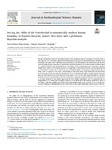Mostrar o rexistro simple do ítem
Sorting the Riddle of the Neanderthal to Anatomically Modern Human Boundary in Sopeña (Asturias, Spain): New Dates and a Preliminar Bayesian Analysis
| dc.contributor.author | Pinto, Ana | |
| dc.contributor.author | Grandal-d'Anglade, Aurora | |
| dc.date.accessioned | 2023-02-01T20:23:55Z | |
| dc.date.available | 2023-02-01T20:23:55Z | |
| dc.date.issued | 2022-09-02 | |
| dc.identifier.citation | Ana Cristina Pinto-Llona, Aurora Grandal-d'Anglade, Sorting the riddle of the Neanderthal to anatomically modern human boundary in Sopeña (Asturias, Spain): New dates and a preliminar Bayesian analysis, Journal of Archaeological Science: Reports, Volume 45, 2022, 103607, ISSN 2352-409X, https://doi.org/10.1016/j.jasrep.2022.103607. (https://www.sciencedirect.com/science/article/pii/S2352409X2200270X) | es_ES |
| dc.identifier.issn | 2352-409X | |
| dc.identifier.uri | http://hdl.handle.net/2183/32425 | |
| dc.description | Financiado para publicación en acceso aberto: Universidade da Coruña/CISUG | es_ES |
| dc.description.abstract | [Abstract] Sopeña is a limestone shelter in the northern slopes of the Cantabrian range of mountains of northern Spain. A long sequence of in situ nearly undisturbed archaeological strata has been documented there, including seven Gravettian, four Early Upper Palaeolithic and a minimum of four Mousterian levels, and bedrock has not been reached. Dating the last occupations by Neanderthals and their substitution by modern humans in northern Spain is a currently debated issue, made difficult by the scarcity of sites bearing those levels and able to produce reliable dates. Earlier work in Sopeña pointed to a disappearance of the Mousterian that was later than proposed by other authors on other sites of what is known as Cantabrian Spain, a mountainous fringe facing the Bay of Biscay. Here we present 11 new dates, corresponding to Gravettian, Early Upper Palaeolithic and Mousterian levels, and some of these new dates are ultrafiltered. It is concluded that although the earliest Sopeña Gravettian dates are older than those proposed elsewhere in the region, we do not have still enough information to produce a definite model for the Gravettian of this site. Furthermore, a Bayesian model is produced for the interpretation of the dates obtained for the earliest Upper and the latest Middle Palaeolithic, and it is concluded that the disappearance of the Mousterian in Sopeña is indeed a few millennia later than currently proposed by others in the region, while that available dates cannot shed unquestionable light on the existence or not of a hiatus between the dismissal of Neanderthals and the earliest arrival othe Upper Palaeolithic technocultures at the site. | es_ES |
| dc.description.sponsorship | The dating of the new bone samples from Sopeña was made possible thanks to the financial support of the PalArq Foundation (https://fundacionpalarq.com/). Funding for open access: Universidade da Coruña/CISUG | es_ES |
| dc.language.iso | eng | es_ES |
| dc.publisher | Elsevier | es_ES |
| dc.relation.uri | https://doi.org/10.1016/j.jasrep.2022.103607 | es_ES |
| dc.rights | Atribución 4.0 Internacional | es_ES |
| dc.rights.uri | http://creativecommons.org/licenses/by/4.0/ | * |
| dc.subject | Mousterian | es_ES |
| dc.subject | Early Upper Palaeolithic | es_ES |
| dc.subject | Gravettian | es_ES |
| dc.subject | AMS dating | es_ES |
| dc.subject | Ultrafiltered dates | es_ES |
| dc.subject | Neanderthal extinction | es_ES |
| dc.subject | Northern Spain | es_ES |
| dc.title | Sorting the Riddle of the Neanderthal to Anatomically Modern Human Boundary in Sopeña (Asturias, Spain): New Dates and a Preliminar Bayesian Analysis | es_ES |
| dc.type | info:eu-repo/semantics/article | es_ES |
| dc.rights.access | info:eu-repo/semantics/openAccess | es_ES |
| UDC.journalTitle | Journal of Archaeological Science: Reports | es_ES |
| UDC.volume | 45 | es_ES |
| UDC.issue | October 2022 | es_ES |
| UDC.startPage | 103607 | es_ES |
| dc.identifier.doi | 10.1016/j.jasrep.2022.103607 |
Ficheiros no ítem
Este ítem aparece na(s) seguinte(s) colección(s)
-
IUX-CULXEO - Artigos [49]






